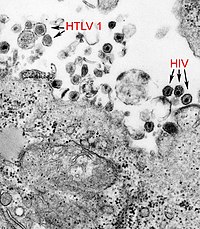
Photo from wikipedia
Cell-to-cell spread of HIV permits ongoing viral replication in the presence of antiretroviral therapy and is suggested to be a major contributor to sexual transmission by mucosal routes. Fusion inhibitors… Click to show full abstract
Cell-to-cell spread of HIV permits ongoing viral replication in the presence of antiretroviral therapy and is suggested to be a major contributor to sexual transmission by mucosal routes. Fusion inhibitors that prevent viral entry have been developed, but their clinical applications have been limited by weak antiviral activity, short half-life, and the low genetic barrier to development of resistance. We examined the inhibitory activities of a series of single-chain variable fragments (scFvs) targeting the V3 and CD4i epitopes against both cell-free and cell-to-cell HIV infection. We found that all anti-V3 scFvs, including two newly constructed scFvs, showed broad neutralization activity against a panel of subtype B viruses compared with the corresponding IgGs. All scFvs neutralized cell-free infection by HIV-1JR-FL WT and fusion inhibitor-resistant mutants. In addition, all anti-V3 scFvs and some CD4i scFvs significantly inhibited cell fusion, while their IgG counterparts did not. Furthermore, scFvs-fusion inhibitors combinations, such as C34 and SC34, showed synergistic inhibition of cell fusion by both HIV-1JR-FL WT and fusion inhibitor-resistant mutants. The most prominent combinational effect was observed for 916B2 CD4i scFv with SC34. The delayed fusion kinetics of fusion inhibitor-resistant mutants partly explain their synergistic inhibition by such combinations. Our data demonstrate the advantages of using scFvs over their parent IgGs for inhibiting both cell-free and cell-to-cell infection. High synergistic inhibition of cell fusion by using scFvs-fusion inhibitors combinations suggests the possibility of intensification therapy adding this combination to current anti-HIV treatment regimens.
Journal Title: Biochemistry and Biophysics Reports
Year Published: 2019
Link to full text (if available)
Share on Social Media: Sign Up to like & get
recommendations!